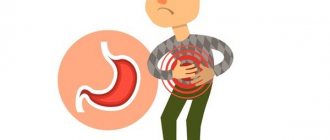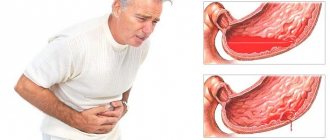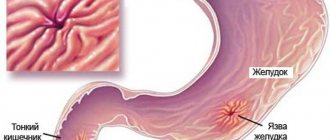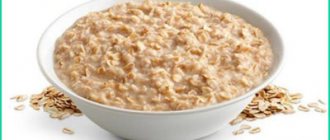The name is beautiful, sometimes even romantic, but absolutely incomprehensible and frightening for a patient ignorant of medical terminology.
We propose to understand in detail what cascade deformation of the main digestive organ is and whether it is dangerous to health.
What does the concept of cascading stomach mean?
This term is usually understood as deformation or bending of this digestive organ. The anomaly may be congenital or acquired. According to statistics, this diagnosis is given to 5% of patients. As a rule, it becomes the result of various diseases - for example, gastric ulcers.
Concept of the cascading stomach.
Quite often situations arise when the digestive organ changes its shape every day. This may be due to a sudden change in diet and eating habits.
Main signs of the disease
Judging by the reviews of patients and doctors, the following symptoms are observed with cascading stomach:
- Feeling full and heavy after eating.
- Feeling nauseous.
- Attacks of vomiting.
With this disease, these symptoms are observed constantly or periodically. They resemble general signs of malfunctions of the digestive system, which proves the connection of the cascade stomach with other gastrointestinal pathologies.
Causes of the pathological form
A cascading stomach may be a consequence of congenital or functional factors. However, sometimes this anomaly is caused by the development of various pathologies. These include the following:
- gastritis;
- colitis;
- peptic ulcer;
- duodenitis;
- cholecystitis.
If the disease could not be identified during diagnosis, then the anomaly in the structure of the stomach is classified as a functional disorder. A common cause from this group of factors is the pressure of a loop of intestine on the stomach. It may increase due to excess gas formation.
In this case, the doctor may ask the person to perform a simple action: he needs to tense up a little and bend forward 10 times. This will help eliminate cascades.
If this measure does not help, the specialist must conduct a thorough examination of the cardiac and other parts of the organ for the presence of oncological pathologies. Such violations are quite easy to miss in cascades.
In addition to these reasons, a cascading stomach can be a consequence of aerophagia. Severe stressful situations or progressive paralysis lead to changes in the shape of the organ.
In medical practice, this anomaly occurs not only in adults. Sometimes this form of stomach can be seen in a child. Most often, organ deformation is detected during radiography. The study allows you to visualize the stomach folded in half, which resembles pockets.
This type of deformity often provokes constant regurgitation and vomiting in infants. Due to the bend, food is not able to enter the pylorus, and therefore is thrown out of the stomach. This condition is most often temporary. As a rule, it lasts until the baby is six months old.
To cope with this problem, the baby should be placed on his tummy before each feeding. This simple technique helps straighten the stomach. In this situation, the deformity is considered normal and does not require treatment.
Candidiasis of the intestines and esophagus
Esophageal candidiasis (otherwise known as candidal esophagitis) is accompanied by:
- heartburn, burning in the pharynx - these signs do not appear immediately, but after 2-3 weeks from the onset of the disease;
- the appearance of a white coating in the mouth with an unpleasant odor.
- difficulty swallowing (severe) due to blocking of the lumen of the esophagus with candidal films.
Intestinal damage by Cand fungi >
Common signs for the above types of candidiasis are:
- weakness, drowsiness, malaise,
- decreased ability to work,
- loss of appetite,
- elevated body temperature.
Diagnosis of pathology
To identify this anomaly, the doctor may prescribe fibrogastroscopy. Assessment of the acidity of gastric juice and radiography of the digestive organs have high diagnostic value.
It is the x-ray that allows you to study the structure of the stomach in detail. It is important to take into account that the usual anatomical picture may differ slightly from the image obtained as a result of this study.
Cascade stomach on x-ray
This factor can be explained quite simply. In reality, the stomach is under the influence of tone. It is also influenced by hydrodynamic factors. In addition, the structure of the digestive system can differ significantly from person to person.
Advice from the chief gastroenterologist!
Korotov S.V.: “I can recommend only one remedy for the rapid treatment of ulcers and gastritis, which is now recommended by the Ministry of Health...”
X-rays are performed after receiving the results of general and biochemical tests, as well as assessing the acidity of gastric juice.
Before the start of the study, the person is sent for an examination, during which the gastric mucosa is assessed. Also at this stage it is very important to determine the tone of the organ, the condition of the gas bladder and duodenum.
It is important to consider that the gas bubble can have different shapes. This is due to varying degrees of gas formation in the cardiac part of the stomach.
During radiography, the contrast enters under the gas bubble. This ensures a complete examination of the lower zone of the stomach. To avoid the need to repeat this procedure, you must strictly adhere to the technique.
During an X-ray examination, the doctor takes overview and targeted images. This makes it possible to examine the surface of the gastric mucosa. All irregularities can be visualized through the use of contrast.
With the cascade form of the stomach, the substance fills exclusively the upper section of the organ. However, applying a lot of contrast causes it to move like a waterfall.
When analyzing the front view image, the digestive organ appears too short. An image taken in lateral projections demonstrates the peculiar shape of the stomach. Its vault can be localized at the same level as the pylorus.
Timely diagnosis allows you to take measures to correct the shape of the organ. To do this, doctors may prescribe medications or perform special exercises.
EUS for thickening of the stomach
The main diagnostic method is endoscopic ultrasound. It involves the use of an echoendoscope, at the end of which there is a miniature sensor and a special optical device that allow you to carefully study the relief of the stomach. Modern equipment has a high resolution, up to 1 mm. Such accuracy is not available with other methods. The effectiveness of the examination is also guaranteed by the use of high-frequency ultrasound, which penetrates into the deepest layers of the mucosa.
Treatment methods
Currently, there are several methods that help straighten a deformed stomach. First of all, experts advise doing a special exercise, which involves bending to the right and left sides.
If the pathology provokes dyspeptic symptoms, you need to avoid excessive physical activity, which is accompanied by strong tension in the abdominal muscles and requires lifting heavy objects. Also, doctors do not advise people with this diagnosis to use tight belts.
The photo shows a change in the position of the stomach.
If a person experiences unpleasant symptoms such as frequent belching, heartburn, or abdominal discomfort, medications may be prescribed. Typically, agents are used that coat the walls of the stomach, reduce the activity of enzymatic juice and help protect the mucous membranes. These include phosphalugel, maalox, cerucal.
If necessary, the patient may be prescribed painkillers and antispasmodics. Physiotherapy is also very actively used.
Folk remedies will help speed up the recovery process:
- It is recommended to drink freshly squeezed cabbage juice for a month.
- Grind 500 g of aloe using a meat grinder, add 500 g of honey and cook in a steam bath, stirring constantly. Pour in 500 ml of red wine and leave the mixture to steep for a week. Then take 5 g for 7 days an hour before meals. After this, the dosage can be increased to 10 g. After another 7 days, the product can be consumed 10 g 2 times a day.
- Make a decoction based on linden, chamomile, mint and yarrow. Cook for 10 minutes, then leave to cool completely. Drink the strained mixture three times a day. It is recommended to take 100 ml of the product at a time.
- Mix honey and plantain juice in equal parts. Cook the resulting mixture for 20 minutes. Drink 10 g twice a day. It is recommended to do this before meals.
To cope with stomach deformation, it is very important to adhere to a special diet and follow a food intake schedule. You need to eat small portions 5 times a day, and preference should be given to warm dishes.
It is recommended to use vegetable broth for making soups. Doctors advise avoiding baked goods and fried foods. Canned foods and pickles are prohibited. It is also necessary to completely eliminate alcohol.
Cascading stomach is a fairly serious disorder that can be a consequence of various diseases. To establish the causes of this anomaly, it is necessary to conduct a thorough diagnosis. Thanks to this, the doctor will be able to select adequate treatment.
Very often, having heard the term “cascaded stomach,” people wonder: what is it and how is it different from a regular stomach.
This term is used particularly in X-ray and endoscopic studies; it indicates that the shape of the stomach is changed for one reason or another. Today we will look at what a cascade stomach is, what is the peculiarity of this anomaly and against what background it can manifest itself.
Pathologies diagnosed by ultrasound of the stomach
Can ultrasound reliably detect stomach diseases? During the procedure, changes are visible that may indicate the following diseases and changes:
- Gastroesophageal reflux (pathology is indicated by the presence of fluid in the cardiac part of the organ).
- Diaphragmatic hernia (can be diagnosed if there is a small amount of fluid in the stomach). Accurate measurements of pathology cannot be made using ultrasound.
- Swelling of the walls.
- Foreign objects in the stomach.
- Cystic formations are defined as dense, round lesions with clear boundaries. The muscles outside the cyst are hypoechoic, the mucous membrane inside is echogenic.
- Neoplastic wall thickening (diffuse form).
- Neoplasms of malignant and benign etiology.
- Varicose veins of the gastric veins.
- In pediatrics, gastric ultrasound is used to diagnose pyloric stenosis.
For uncertain but recorded changes during ultrasound examination of the stomach, there is the term “hollow organ lesion syndrome” - which means any diagnosis that requires confirmation by another hardware, instrumental or laboratory method.
In many cases, additional diagnostic techniques are used - CT, MRI, radiography - to confirm and detail the data obtained on ultrasound.
What is cascade stomach
Important! In this case, the usual exercise will help eliminate cascading violations - with a little tension you need to do about ten bends forward.
What is cascading stomach and its causes?
A cascade stomach is a bend in the stomach, that is, its deformation, which is divided into congenital and acquired. Often this process occurs against the background of existing pathologies of the digestive organ - for example, ulcers. It should be noted that the bend is diagnosed in 5% of patients, that is, in 5 cases out of 100 known. In addition, there are reasons that force the stomach to change its shape almost every day - these are changes in diet, as well as changes in food consumption. Various pathologies are directly related to the formation of a cascade stomach and here are some of the most common:
- Gastritis.
- Colitis.
- Ulcer.
- Duodenitis.
- Cholecystitis.
If the cascade stomach was not formed due to the development of one of the pathologies described above, then perhaps the factors are:
- The functional nature of the disorder means that no concomitant diseases have been identified - in this case, a possible change in shape occurs due to the pressure of the intestinal loop on the digestive organ. This occurs due to increased accumulation of gases in this area.
- Oncological diseases often provoke changes in the size and shape of many organs, including the stomach - the peculiarity is that this pathology is difficult to notice in cascades.
- Severe stress also leads to disturbances in the functioning of the digestive system, and if a cascading stomach is formed due to them much less frequently, such cases are still documented.
The term "cascading stomach" is not only used for adults. Very often, such a conclusion can be found after an X-ray examination of the child. In this case, the stomach is bent in half and resembles pockets from the side. In addition, the cascade form is often noticed in newborns - this deformation leads to frequent regurgitation and vomiting. Often this pathology is temporary and goes away on its own when the child is 6-7 months old.
Important! The advice of grandmothers and pediatricians about placing the baby on the tummy before each feeding is the most optimal solution to the problem, since in this case the stomach straightens and ultimately takes on a natural and normal shape.
Deformations on X-ray
An X-ray examination of the organ is carried out after the results of general blood and urine tests, biochemistry, and gastric acidity are obtained. Before the x-ray, a study of the gas bubble, the relief of the mucous membrane of the organ, the tone of the stomach and the functioning of the duodenum is carried out.
Gas bubble - accumulations of gases that differ in shape in the cardinal section of the organ. With an x-ray, the contrast flows under it and it is possible to examine the bottom of the organ. The procedure must be performed consistently and strictly according to the methodology in order to obtain the best possible results and do not require repeated diagnostics. An overview and targeted photograph is taken. This makes it possible to examine the relief of the mucous membranes and their irregularities, which are clearly shown by the shadow of the contrast agent.
A normotonic stomach is characterized by the fact that the contrast slowly enters the caudal part of the stomach. The gas bubble is spherical in shape. With a hypotonic stomach, on the contrary, the contrast agent quickly flows into the antrum and takes on a cup-shaped shape. The horn-shaped stomach is most often found in people who are overweight, since their antrum is higher than in people of normal build. If the patient turns in any direction, the organ takes on a hook shape. The horn-shaped stomach can become due to a severe organic or functional disorder.
Deformation of the stomach can also consist of its displacement. Kinds:
- passive;
- active.
Passive displacement of the stomach can be noticed using normal palpation when changing body position. An active shift is visible when breathing from the diaphragm, when the abdominal cavity is drawn in and out. When retracting, the abdominal muscles must be pulled in as much as possible. Such displacements are most often provoked by various pathologies, for example, adhesions, an enlarged liver, etc. Deformations and displacements of the stomach can affect organs that are nearby.
The hourglass shape is caused by scarring. This is a scar constriction that seems to divide the organ into 2 parts, between which there is a small gap. A snail-shaped stomach is obtained when the lesser curvature becomes smaller and the greater curvature lengthens. Cascade is formed due to the transverse bending of the organ.
Stomach in the form of a cascade
The x-ray shows that a bend has formed in the organ, due to which 2 levels are formed in it. This pathology can appear against the background of aerophagia, severe stress, or in cases where paralysis progresses. It is also caused by diseases of the gastrointestinal tract, including malignant tumors. Such a kink needs to be straightened, and if this cannot be done, doctors look for the reason that prevents the successful completion of the procedure.
Symptoms of pathology
Symptoms of cascading stomach
The symptoms that appear with cascading stomach resemble other common diseases. This is precisely what indicates a direct connection between this pathology and existing disorders in the digestive system. What symptoms should you pay attention to in case of cascade stomach in order to suspect an anomaly in time:
- Feeling of heaviness in the stomach after eating.
- Nausea.
- Decreased appetite for no particular reason.
- Vomiting.
- Uncontrolled weight loss.
If these symptoms appear to you very often or have a characteristic periodicity, then you definitely need to see a doctor, who, after prescribing a series of necessary tests, will reveal or refute the excess.
Understanding stage 4 stomach cancer
The presence of certain symptoms depends on the degree of gastric prolapse.
The severity of the pathology can be determined by the location of the lesser curvature. This part of the stomach is the uppermost and is immobile. There are 3 degrees of severity of a torn stomach:
- 1st – lesser curvature is located 20-30 mm above the gallbladder;
- 2nd – the curvature is in line with the gallbladder;
- 3rd – the curvature is below the level of the gallbladder.
Signs of a torn stomach in the first 2 degrees are smoothed out. Symptoms of a torn stomach only occasionally bother the patient.
Symptoms that require attention:
- feeling of heaviness in the epigastrium after a heavy meal;
- surges in appetite: reluctance to eat is replaced by wild appetite;
- irresistible cravings for spicy food;
- non-acceptance of dairy products.
Additional symptoms that may appear:
- urge to feel sick for no apparent reason;
- belching;
- excessive gas formation;
- problems with bowel movements (frequent constipation).
| Type of prolapse | Characteristic symptoms |
| Constitutional | Increased heart rate, chronic nausea and dizziness, decreased appetite. |
| Acquired | Heaviness after eating fatty foods, frequent attacks of nausea and vomiting, regular constipation. Against this background, tastes in food change. |
| Total | Pain in the abdomen and pelvis becomes constant and prolonged. Their cause is sudden movements and little physical activity. Food is poorly digested. |
Kink treatment methods
Treatment of cascade stomach
Treatment of a cascading stomach consists of following certain rules and performing exercises that will actively influence the change in the shape of the digestive organ. Therefore, by following all the doctor’s instructions, you will be able to cope with the anomaly. This process can be quite lengthy, but in the end there is a huge benefit to returning a person to a normal and active life. Let's look at several methods by which treatment will be most effective:
- A person with a bent stomach should perform a simple exercise, which consists of bending to the right and left.
- It is best to rid yourself of physical activity, stop carrying heavy bags, and use tight belts.
- Treatment consists of taking medications if the pathology is accompanied by belching, heartburn and pain. In the latter case, painkillers are prescribed.
- Dietary nutrition plays an important role and not a single treatment has been successful without eating the right foods. During treatment, as well as as a preventive measure for gastrointestinal diseases, you should eat at least 5-6 times a day, while taking even breaks between meals. After each meal you should feel a slight feeling of hunger.
- Very often, people with stomach diseases use traditional medicine options. This has its advantages, but before you start using this or that decoction, you should consult your doctor. Among the most popular folk methods, decoctions based on plantain, linden and mint, honey and aloe are welcome.
- Treatment consists of additional avoidance of heavy and difficult-to-digest foods. The therapeutic diet is aimed at consuming light vegetable soups, ground and boiled porridges, and boiled dietary meat. Fried foods and fresh baked goods are prohibited; in addition, the consumption of spicy and canned foods is unacceptable.
The cascading structure of the stomach is a fairly serious disorder, which is most often provoked by the destructive effect of another disease. That is why it is important to quickly diagnose and identify the causes of the bend. Only timely initiation of treatment allows one to cope with the deformation without triggering destructive processes that can occur in the digestive system.
The digestion process is easy to disrupt due to poor nutrition, bad habits and stress, but it is difficult to restore. One of the malfunctions in the gastrointestinal tract is the cascade stomach. The phenomenon is not considered a disease and is characterized by a change in the shape of the digestive organ. Pathology can be diagnosed by endoscopic examination and radiographs.
Causes of weakened immunity
A person's immune status may be weakened by:
- protracted infectious diseases and diabetes mellitus,
- the presence of malignant tumors,
- various types of injuries,
- long-term treatment with antibiotics,
- unfavorable socio-economic situation.
The age factor plays an important role: most often, elderly people and children suffer from gastric candidiasis. People who have AIDS, oncology, diabetes mellitus, chronic diseases of the thyroid gland, kidneys, esophagus, intestines, and stomach are also at risk of fungal infection. With internal bleeding or a cancerous tumor, Candida fungi can grow through the walls of the affected organ, thereby causing life-threatening consequences.
What it is?
A bend in the gastric pouch in children causes frequent nausea and regurgitation.
The stomach is capable of changing its shape depending on the size of the portion, the type of food and the position of the person’s body while eating. Changes occur throughout life and are not considered dangerous. But when a cascade is formed, an organ bends. This curvature occurs in 5% of patients. Before a meal, the stomach looks like a flat bag, but when food enters it and reaches the bottom, the organ enlarges, becomes convex and oblong.
In the case of a cascade violation, the stomach is bent so that it twists around its axis and forms 2 levels, similar to cascades. During examination, the anterior section appears shortened, and the fornix is lowered below the normal position and placed at the height of the pylorus. Due to sudden changes in diet and dietary habits, the stomach can take different forms every day.
Return to contents
What are the reasons for the violation?
The development of the disease can be facilitated by an inflammatory process in the gallbladder.
There are congenital and acquired forms of the cascade stomach. Factors influencing the development of the phenomenon throughout life are considered to be inflammatory processes that provoke the formation of scars. These include diseases such as:
- stomach ulcer;
- inflammation of the serous membrane of the organ;
- periduodenitis;
- colitis;
- gastritis;
- inflammation of the gallbladder.
If gastrointestinal diseases were not detected during diagnosis, gastric deformity is considered a functional disorder. Often the cause of the pathology is compression of the stomach by an intestinal loop, enlarged against the background of intense gas formation. In this case, to eliminate the violation, it is enough to do simple exercises. It is recommended to bend to the sides, forward and backward, keeping your stomach slightly tense.
Return to contents
What factors contribute to the development of pathology?
Cascade stomach can be a congenital or acquired deformity. The main reasons that provoke its occurrence include inflammatory processes leading to the formation of scar tissue. Experts name the following factors contributing to the development of the disease:
- Peptic ulcer disease.
- Inflammation of the stomach lining.
- Duodenitis.
- Cholecystitis.
- Inflammatory processes in the large intestine.
Sometimes the disease develops in the absence of the above circumstances. In such a case, its occurrence is explained by the following reasons:
- Compression of the stomach by a loop of intestine as a result of the formation of a large amount of gas.
- Malignant neoplasm. Cancer pathologies often lead to deformation of the organ, changes in its size and structure. With a cascade stomach, diagnosing a tumor is quite difficult.
- Emotional stress. In rare cases, stressful situations accompanied by disruptions in the gastrointestinal tract lead to deformation of the organ.
Cascade stomach is a serious organ deformity that is usually associated with other pathologies of the digestive system. To avoid this disease, it is necessary to adhere to the correct diet, avoid eating foods harmful to the gastrointestinal tract (smoked meats, pickles, canned food, spices), and give up bad habits (smoking, drinking alcohol-containing drinks).
It is important to avoid overeating; eat often, but in small quantities. You should also exercise regularly and maintain good posture. If you have symptoms indicating digestive problems, there is no need to postpone a visit to the doctor. Diagnostic measures allow you to detect pathology in time, begin treatment and avoid negative consequences.
Diagnostics
A baby's cascading stomach can be straightened by placing the baby on his stomach.
As part of the diagnosis, the following methods are used:
- fluoroscopy;
- fibrogastroscopy;
- determination of gastric juice acidity.
After clinical tests, radiography is performed, which most clearly demonstrates the existing kinks in the organ. To conduct the study, a contrast agent is used - a suspension of barium, which is injected into the gastric cavity. The time for removing the component from the body does not exceed 2 hours. The picture shows a fracture of the organ. The upper compartment is wide, the lower one is narrowed. In this case, the doctor takes into account the tone of the gastric muscles and the level of peristalsis.
The definition of motor skills is based on the study of such factors:
The state of the nervous system determines the quality of the digestive organ.
- chemical composition of the organ contents;
- muscle tone;
- characteristics of the patient’s hormonal background;
- state of the nervous system.
Having identified the cascade stomach, it is important to study peristalsis to determine the elasticity of the walls of the organ in the future. As practice shows, when malignant tumors form, wave attenuation is observed at their locations. As part of the diagnosis, a series of images are taken. The diagnosis and degree of organ damage is determined only on the basis of general data. Treatment is selected after examination.
Return to contents
How is the research conducted?
Examination of the stomach can be divided into abdominal ultrasound and gastroscopy. Gastroscopy is a research method in which a person swallows a special probe with a light bulb and a video camera.
To examine the stomach without swallowing a probe with a light bulb, you can do a regular ultrasound of the stomach through the anterior abdominal wall. But gastroscopy is all the better because the doctor can examine the internal organs from the inside. Therefore, these two methods should complement each other.
Classic ultrasound examination is performed through the skin of the abdomen, i.e. transabdominally. There are several varieties:
- Ultrasound examination of the stomach is first performed on an empty stomach in the usual way. The person lies on his back and frees his stomach from clothes. Then the doctor conducts an examination using an ultrasound machine. A thorough examination of all the walls of the stomach allows examination in different positions: lying on your back, on your side, standing.
- To determine the contractility of the organ, ultrasound of the stomach is combined with a water-siphon test. To do this, a person drinks a glass of tea without sugar. After a few minutes, a series of repeated tests are carried out to determine how quickly the liquid leaves the stomach. The norm is up to 25 minutes. If the delay is more than 40 minutes, they speak of slow motility of the organ or changes in the sphincter (narrowing, dysfunction, scar deformation).
- To see a stomach or duodenal ulcer on ultrasound or pathological formations, an ultrasound scan of the stomach and duodenum with contrast is performed. The person drinks a solution with a contrast agent, after which a second examination is performed. This improves visualization, since the contrast agent fills folds, wall defects, and improves the visibility of the contour of neoplasms.
A better examination of the upper gastrointestinal tract can be done using endoscopic gastroscopy. This examination is more difficult for people to endure because it is associated with unpleasant sensations during the procedure.
The person is placed on his side and a special mouthpiece is inserted into the mouth, which prevents the teeth from accidentally closing. At the request of the person, local anesthesia can be performed. Then the person needs to swallow the so-called “hose”. This is a flexible sensor with a camera and a light bulb. When the sensor is swallowed, the doctor begins to examine all the walls of the stomach and duodenum.
Gastroscopy allows you to conduct additional examinations: measuring the pH of gastric juice, biopsy, removal of polyps.
- The pH of gastric juice is measured to determine acidity.
- A biopsy is performed to exclude oncology - a piece of tissue is taken to examine the cellular composition under a microscope.
- If there are tumors, you can remove them during the procedure and then send them to the laboratory for examination.
What treatment is prescribed?
Drug therapy
If a person with a cascade form of the stomach is bothered by belching and discomfort in the abdomen, he is prescribed drugs that have an enveloping property. This protects the mucous membrane from the aggressive effects of hydrochloric acid. If necessary, painkillers, antiemetics, and antispasmodics are used. There are no medications that can restore the shape of the organ. Drug therapy is aimed at eliminating the symptoms of the pathology.
Return to contents
Lifestyle
Treatment of a cascade stomach involves following several rules:
It is better for people with this disease not to wear a belt on their stomach.
- Bend to the sides. Alternately reach down with your right and left hands.
- Avoid tight clothing, tight elastic bands and belts on the stomach.
- Minimize physical activity.
- Avoid tensing your abdominal muscles.
- Stop smoking and drinking alcohol.
Return to contents
Nutrition rules
Any disturbance in the functioning of the stomach requires changes in the diet. Regardless of the reason that provoked the cascade form of the organ, you should avoid eating spices, salt, mushrooms, meat and fish broths. It is recommended to remove baked goods and preserves from the menu during treatment. The food should be warm. You need to eat up to 7 times a day in small portions.
Return to contents
ethnoscience
Therapy is selected individually by the doctor. You should not try to eliminate the pathology yourself using herbal medicine. Herbs are used as an adjunct to drug treatment. If a patient is diagnosed with a cascade stomach, the following means can normalize the functioning of the organ:
- fresh cabbage juice;
- herbal decoction based on mint, chamomile, yarrow and linden;
- boiled mixture of plantain juice and honey.
Return to contents
The right diet
For cascading stomach, treatment involves following a diet. The patient should eat food five to six times a day, in small quantities. Breaks between meals should be even. The stomach should not be overloaded. The diet involves introducing into the diet such products as first courses with vegetable broth, pureed cereals, and boiled lean meat.
Spicy, fried, salted and smoked foods, fatty foods, canned food, mushrooms, spices, confectionery, desserts and baked goods are prohibited. Food should not be too hot or too cold. It is better to abstain from foods that cause excessive formation of gases in the intestines (fresh fruits and vegetables, juices with a sour taste). You should give up bad habits (smoking, drinking alcoholic beverages). Sometimes, to eliminate the symptoms of problems with the gastrointestinal tract, plant-based products are used (decoctions of plantain, linden, aloe, mint, honey, chamomile, yarrow, white cabbage). These methods of therapy can only be used after consultation with a doctor.
How to avoid the problem?
As part of the prevention of cascading stomach, you need to get rid of bad habits and normalize your diet. You should avoid smoked meats, fried foods, salt and preserves. You should not overeat, as large amounts of food change the shape of the stomach. It is recommended to monitor your posture, perform feasible physical exercises and avoid stressful situations.
Medicine knows many terms. One of these is the cascade stomach. This pathology is not a disease and practically does not interfere with the patient’s ability to lead a full life. An anomaly is detected during an endoscopic or x-ray examination. Throughout time, the organ can change shape depending on how much food a person eats.
Concept of cascading stomach
The cascade stomach is usually understood as an anomaly, which is characterized by an inflection of the stomach. This type of deformation comes in two types: congenital and acquired. Diagnosed in 5% of patients.
When a person is hungry, the stomach resembles a flat pouch. At this moment, the back and front walls come into contact with each other. Once the organ is filled, it takes on a convex and oblong shape.
During an X-ray examination, you can see how the organ transforms from a horn-shaped to a hook-shaped after it is filled with a contrast agent.
From the picture, the cascading stomach looks like this. The organ has an inflection around its axis. Against this background, 2 elbows are formed: the lower one in the form of a tube and the upper one in the form of a bowl. The anterior projection shows that the vault is located lower than it should be, that is, at the level of the pylorus.
Differentiation of plaque in gastritis from other diseases of the gastrointestinal tract
A thick, grayish coating is characteristic of dysentery.
It is important to suspect the onset of a dangerous disease in time. To take action and prevent complications from occurring. Differential diagnosis by tongue of gastritis from other diseases and conditions:
- A thick, grayish coating is characteristic of dysentery. In this case, the tongue looks cracked, and less saliva is produced than usual.
- Desquamative glossitis - this type of inflammation of the tongue is characterized by such symptoms as red spots of complete absence of epithelium or several altered taste buds on the tongue, covered with a white coating.
- Galvanic stomatitis is a form of inflammation of the tongue that arises as a result of a reaction to metal prostheses, manifested by spots in the form of pimples, and subsequently by the appearance of erosions against a background of white plaque.
- Infectious diseases - sore throat, scarlet fever, diphtheria, HIV infection can cause the appearance of a white coating on the tongue, but almost all of these infections are accompanied by high fever and skin rashes.
- Diseases of the heart and blood vessels - plaque is located on the anterior third of the tongue.
- Kidney disease - plaque on the tongue is localized at the back along the edges.
- Endocrine disorders - under the plaques of white plaque there are ulcers and erosions.
- Anemia is not a coating on the tongue, but blanching of the entire surface of the organ. Diseases of the respiratory system are often indicated by the localization of white plaque on the front and along the edges of the tongue.
- Diseases of the salivary glands - the appearance of a white coating is accompanied by the appearance of an unpleasant odor.
- Diseases of the liver and gall bladder - the color of the plaque is not white, but has a yellowish or brown tint. A white coating on the tongue can be caused by the consumption of dairy products, as well as the proliferation of bacteria and fungi in those who abuse sweets. Unlike plaque during gastritis, such layers are easily removed and do not form further.
Causes of cascading stomach
The cascade stomach is formed for two reasons: congenital and acquired. The following can lead to the appearance of pathology:
- inflammatory processes in the stomach;
- enterocolitis;
- ulcerative lesion;
- inflammation in the duodenum;
- inflammation in the gallbladder.
If during diagnostic measures the cause could not be identified, then the pathology is of a functional type. One of the common factors is the pressure of the stomach from the intestinal canal. The digestive tract increases in size with increased gas formation.
The cascade stomach is formed when the body is in a constant state of stress.
This pathological process occurs not only in adults, but also in children. Most often, an unusually shaped organ is formed in the womb. Therefore, the disease is usually called congenital. Diagnosed using ultrasound. After birth, the baby is given an x-ray, where the diagnosis is confirmed.
The picture shows that the stomach resembles pockets. This type of destructive change causes frequent regurgitation and vomiting in the infant. This phenomenon occurs due to the fact that food cannot enter the gatekeeper, and therefore comes out back. Usually the pathology disappears on its own after reaching 6 months.
Ways of infection with gastrointestinal candidiasis
The location of candidiasis infection is most often the stomach, where the fungus penetrates naturally: through the oral cavity, through the esophagus. Infection with the disease can occur in several ways:
- upon contact with contaminated objects (dirty things, poorly washed vegetables, fruits);
- during childbirth - from an infected mother to a baby,
- from a sick person to a healthy person by airborne droplets.
The disease can also develop directly from Candida fungi, which live in the human body and are part of the normal microflora of the organ. Under the influence of negative factors, the latter can give rise to a pathological process called “candidiasis.”
Clinical picture
The symptomatic picture resembles other diseases. It is difficult to determine the type of anomaly on your own. Only a doctor and a thorough examination will help solve the problem.
Symptoms of an inverted stomach include the following:
- a feeling of heaviness in the stomach after eating;
- nausea;
- decreased appetite for no good reason;
- gagging;
- uncontrolled weight loss.
If such symptoms occur frequently, then this is a reason to consult a doctor. If there is deformation, the doctor will give several recommendations.
Diet and stomach prolapse
In practice, doctors often encounter partial gastric failure. The undermined stomach lengthens, its peristalsis sharply worsens.
If a woman has upset her stomach, then nutritional correction will help as a treatment option.
Here are the basic principles of the diet:
- Eat more cereals, vegetables, lean meats, and dairy products.
- Avoid white bread and pastries. Replace them with wholemeal bread.
- Dress salads with low-fat kefir and olive oil.
- After each meal, lie down for at least an hour.
- Eat small meals 6 times a day.
Diagnostic measures
As soon as symptoms of a cascade stomach appear, the gastroenterologist prescribes an examination. The first step is fibrogastroduodenoscopy. During the procedure, gastric juice is collected to determine the acidity level.
After this, an x-ray examination is prescribed. First, the condition of the mucous membrane is assessed. In addition, the tone of the duodenum and gas bladder is established.
It is also necessary to take into account that the gas bubble has a different shape. This is explained by the different amounts of gases that accumulate in the cardiac region of the gastric cavity.
During an x-ray, the contrast agent enters under the gas bubble. In this way, the lower part of the organ can be examined with high accuracy. To get the right result, you need to strictly adhere to all techniques.
During the examination, the doctor takes several pictures. X-ray signs of stomach cancer must be compared. When identifying bulges, the doctor focuses his attention and examines this area more carefully. The gas bubble of the stomach will not be filled with liquid on the x-ray. In this case, the contrast agent will spread throughout the upper part of the organ.
Possible consequences and complications
The high safety of EGD of the stomach is determined by proper preparation of the patient and compliance with the research technique. However, like any medical method, endoscopy can lead to certain consequences:
- Increased stomach acidity with the possible development of small erosions and reflux esophagitis, which is especially often observed in patients with cardia insufficiency and hiatal hernia.
- Violation of the integrity of the mucous membrane or the entire wall, which can lead to the development of inflammation in the mediastinum or abdominal cavity.
- Mechanical damage to the junction of the esophagus and the stomach, which can cause cardia insufficiency with the subsequent development of gastroesophageal reflux disease.
Therapeutic measures
After an X-ray of stomach cancer is taken, the doctor selects a more appropriate treatment strategy. If a cascade stomach is detected, treatment consists of following some recommendations and special exercises. This will help gradually get rid of the bend. But the process will be long.
For treatment to be effective, the following techniques must be used.
- A patient with an inverted stomach needs to do one exercise regularly. It consists of bending to the right and left.
- If you have a cascading hourglass-shaped stomach, you should avoid any physical activity during treatment. Do not carry heavy bags or use tight belts.
- Treatment for ulcers and gastritis involves the use of medications if the pathologies are accompanied by unpleasant symptoms such as belching, heartburn and pain. Taking painkillers is also recommended.
- Chemotherapy is used for cancer. At a more severe stage, surgical intervention is performed. After this, the organ should gradually take its original shape.
- After the x-ray and diagnosis, you must strictly follow the diet. It is worth eating up to 5-6 times a day. In this case, breaks between doses should be 2–3 hours. After eating food, a person should feel slightly hungry. Fatty and fried foods, spices and seasonings, smoked foods and pickles are excluded from the diet. Carbonated and alcoholic drinks are strictly prohibited.
- The correct menu is based on the consumption of stewed, boiled and steamed dishes. Food should be light, but rich in fiber, proteins and carbohydrates.
Traditional recipes are used as an additional treatment method.
- You should drink cabbage juice for 30 days. It not only helps straighten the organ, but also heals the mucous membrane and normalizes the digestive process.
- To prepare the product you will need 500 g of aloe and honey. The components are connected to each other and heated in a water bath. To prevent lumps from forming, the mixture should be stirred regularly. After this, the composition should infuse for another 7 days. Take 1 teaspoon three times a day.
- A decoction based on linden, chamomile, mint and yarrow has a good effect. Cooking time: 10 minutes. The medicine is used 3 times a day.
- Honey and plantain are mixed in equal proportions. The resulting composition is heated on the stove for 15 minutes. Drink in the morning on an empty stomach and in the evening before going to bed.
Treatment with folk remedies is carried out until the symptoms disappear and the stomach returns to its original position.
Performing endoscopy of the stomach
FGDS of the stomach reveals various diseases of this organ. However, a highly informative procedure can only be achieved if the rules for its implementation are followed.
FGDS of the stomach should always be performed only in appropriate conditions and by trained doctors.
All studies are carried out in a special endoscopy room. The patient is placed on the couch, most often on the left side. Using a local anesthetic in the form of a spray, anesthesia of the oral mucosa is achieved. Why is this necessary? This allows you to get rid of the gag reflex that develops when the fiberscope is inserted. After the anesthesia has taken effect, the endoscope is inserted into the patient through the mouth. Gradually moving the device deeper into the esophagus, the doctor begins to examine the mucous membranes and can detect pathology even in the first stages of the examination.
After examining the gastric mucosa, you can examine the duodenum, which is indicated if concomitant diseases of this localization are suspected (neoplasms, ulcerative defects, etc.). After completing the procedure, the doctor carefully removes the endoscope. If the study was carried out using only local anesthesia, the patient remains in the medical facility for 20-30 minutes. If general anesthesia was used, then the patient is prescribed a ward regime in a hospital setting for one day.
Preventive actions
Acquire a cascading stomach shape at any time throughout your life. The cause may be pathological or functional. If we are talking about children, then perhaps the anomaly has a congenital form, which means nothing can be done about it.
To prevent this problem from occurring, it is necessary to adhere to certain preventive measures.
- Check with your doctor regularly. Diagnostics should be repeated 1-2 times a year.
- If the patient has developed gastritis, ulcers or other inflammatory processes, it is necessary to undergo timely treatment. It is prohibited to use medications and folk remedies on your own, as this can lead to complications.
- Avoid stressful situations. For regular depression, it is recommended to drink sedatives of herbal origin.
- Stick to proper nutrition. The diet should consist of vegetables, fruits, dietary meat and fish, cereals and soups. You should completely give up fast food, processed foods, fatty and fried foods.
If the patient is regularly bothered by unpleasant symptoms, then it is better to seek help from a doctor. X-ray and fibrogastroduodenoscopy will help determine the pathology.











